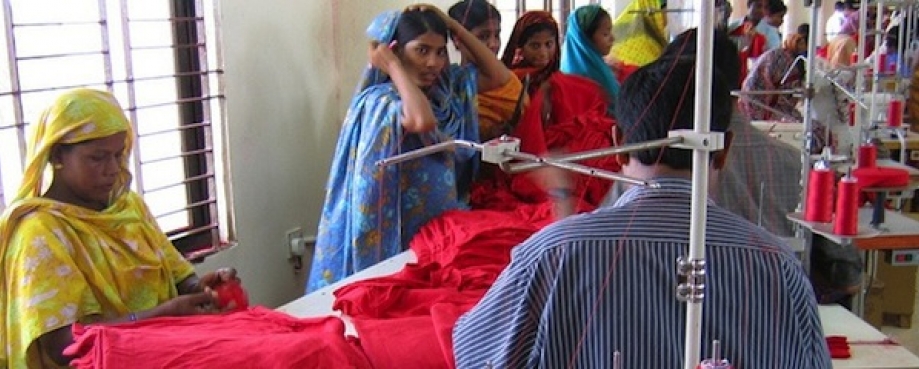
The minimum wage for garment workers in Bangladesh has been raised. But will workers get the full benefit?
Inflation has soared in Bangladesh since the minimum wage was last increased in 2010, and the amount was widely agreed to be inadequate. In the aftermath of Rana Plaza, the Government set up a tripartite wages board. Now it has recommended an increase of 77% in the minimum wages for the garment industry.
With support from the ILO, the tripartite Wages Board has done a reasonable job, visiting two countries with large garment sectors to learn how they manage minimum wages: Cambodia and Vietnam (which has itself just moved from determining the minimum wage by government decree to a tripartite board). It is important that the process should now be institutionalised, as in the UK, so that increases are recommended every year.
The minimum wage (MW) in the Bangladesh garment industry is not a single figure, as in the UK, but stepped with a different minimum rate for different grades. The MW for a helper is less than the MW for a cutter, and so on. The lowest rate has been set at $68 a month, while workers were demanding $100 a month.
Two questions remain:
- Is the new wage enough?
- Will workers get the full benefit?
Is it enough?
Opinions on the minimum wage will be divided. Workers were demanding $100 a month. Is the new level reasonable? We are going to get a bit technical here, but bear with me.
ILO data has shown that countries for which data is available most frequently set their minimum wages at between 35 and 45% of the average wage. On this basis, the ILO Global Wage Report 2008/09 considered that 40% of the average wage represented a useful starting point.
We don’t have such good data on median wages. But where we do, the minimum wage is most frequently set at about 50 to 60 per cent of the median wage. The UK minimum wage – accepted to be on the low side – corresponded to 52 per cent of median wages (in 2010), while the French minimum wage (SMIC) was set at 61 per cent of median wages.
At the risk of being much too simple, if the new minimum wage in Bangladesh is 40% of mean wages, or between 50 - 60% of median wages, that would be in line with international norms.
So far, so good. Where do we get that data? The Bangladesh Bureau of Statistics would be the place to find the data, you would think. But the latest available report is for 2005/6.
Search around and there is a staggering lack of robust data about wages and indeed anything much about the labour force in Bangladesh - ages, education background, family status - anything.
This fact - the lack of research and solid data - in itself speaks volumes about the attitude of the Bangladesh elite towards the people who produce most of the export earnings and wealth of the country.
In the absence of any data to set against the ILO’s benchmark, we will have to go for the estimate of the reliable Bangladesh Institute of Labour Studies: $100 a month, the amount the workers were demanding.
Will workers get the full benefit?
If the wage is raised by 77%, then the workers pay should go up 77%, surely? That is what you might expect, but the last time the Minimum Wage was raised, there was some sharp practice, according to some research by a Bangladeshi NGO, the Alternative Movement for Resources and Freedom (AMRF) Society with the support of Fair Wear Foundation.
Before 2010, workers got paid the old minimum wage plus various bonuses, the most common being an attendance bonus. In 2010, part of the bonus was consolidated into the new minimum rate. The workers did get more cash, but not as much as they would have if the new minimum had been paid with the bonuses intact on top.
The second trick was to re-assign workers to a lower grade. They got more pay, but not as much as if they had stayed on the same grade.
Nobody has challenged the research, so we can assume it describes what happened across many parts of the industry. Will it happen this time?
There is another problem that workers face. Now that the wage increase has been announced, the businesses that live off workers - the slum landlords, food shops, transport - will put their prices up.
You may say there is not a lot anybody can do about that, but I disagree. Back in the 1920s the International Labour Organisation took the view that it was not enough to tackle the conditions at work (hours, safety, and so on) but also the conditions of workers, which would include what went on outside work, like their housing, or access to decent food at decent prices.
Part of the solution for the ILO was co-operatives, providing goods and services for workers at affordable rates. And you can find this approach still in some countries. In Singapore, the TUC there set up a range of consumer co-operatives “to make the workers dollar go further”. You will find co-operatives attached to many older workplaces in India set up in the 1950s.
This must be one option in Dhaka, where garment workers are ripped off by landlords and shopkeepers. It won’t be easy; the co-operative law in Bangladesh is another legal antique, but so long as wages in the sector fall so far behind, and employers play hanky panky, as they say in south Asia, with the minimum wage rates, we need to look at new ways of boosting workers living standards.
